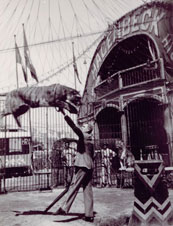by Pascal Jacob
The capturing, taming and training of wild animals is a human activity from time immemorial. These practices have survived through the ages and in the 19th century the development of trade in exotic animals gave the circus the opportunity to modify the content and structure of its activities by including wild animals, elephants, monkeys and trained sea lions.
The first stage of this integration will consist in staging pantomimes whose argument is intended to favour the appearance of tigers, lions or panthers at a strategic moment of the action. They are mostly wild animals from fairground menageries, the first travelling exhibition spaces for creatures that fascinate the public. To continue to arouse the curiosity of the crowds, male and female tamers will quickly boldly dare and challenge each other which leads to an increasingly complex and intricate presentation of their animals.
It was Gottfried Claes Carl Hagenbeck (1810-1887), a German fisherman who became an animal trader, who imposed Hamburg between 1880 and 1960 as the hub of world dressage. As a supplier of menageries, zoological gardens and circuses, the company also contributes to the development of modern dressage by inventing, in particular, the central cage. But the Hagenbeck particularly value new dressage protocols and they found a school in their Stellingen park.
Sometimes regarded as education, dressage proceeds in stages to shape a singular relationship between man and animal. If the big wildcats are the top of a pyramid of possibilities, they are quickly joined by almost all the mammal species, many birds and several reptiles. Germany remains the homeland to understand the importance of discipline on a European scale, but Russia and America are not left out to produce several generations of trainers with vocations encouraged by the taste of the public.
Today, while many countries are legislating to limit or ban animal shows, immersion and taming are taking on a new dimension with the therapeutic training developed in large zoological parks.







